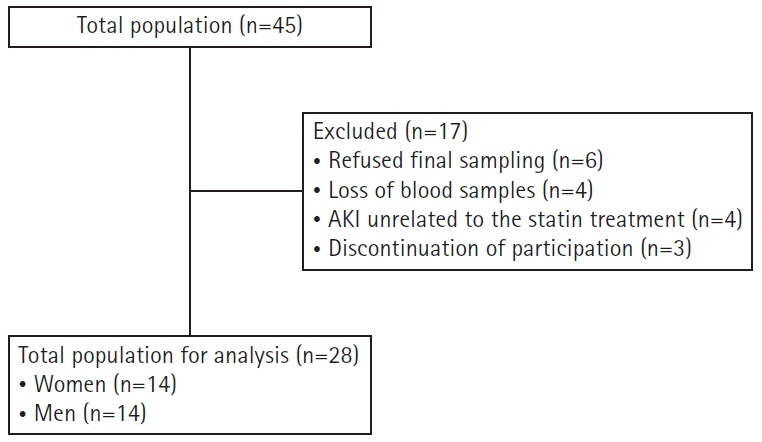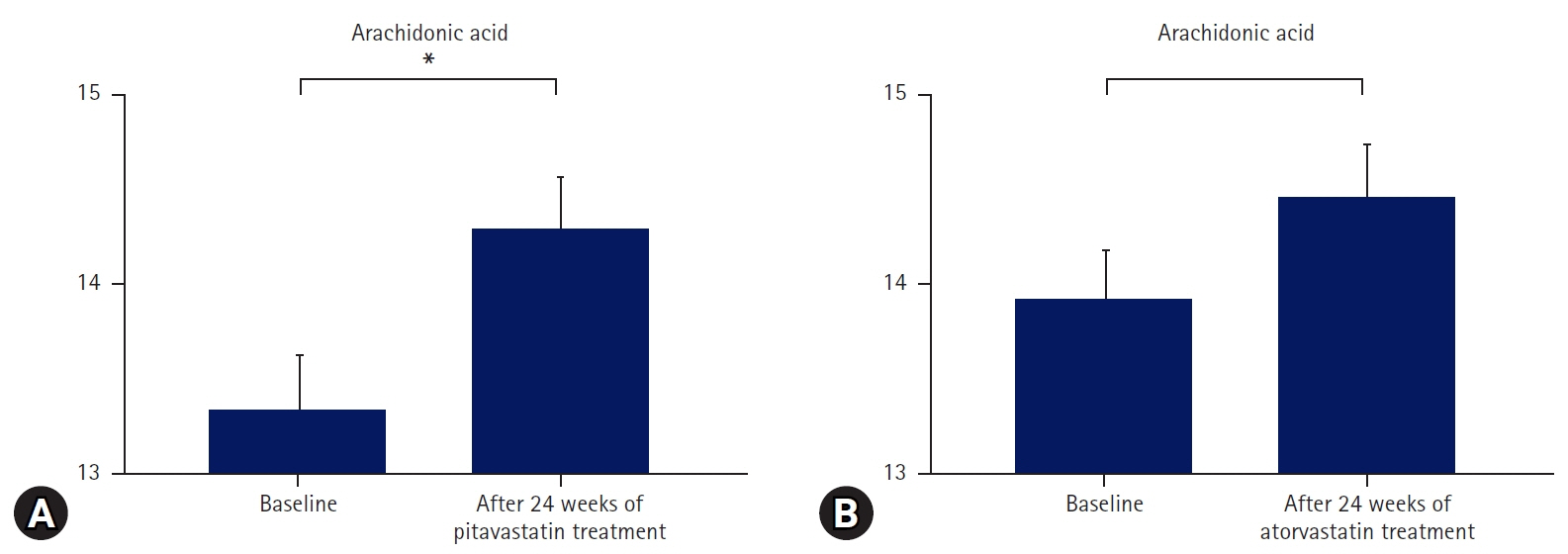J Yeungnam Med Sci.
2024 Jul;41(3):188-195. 10.12701/jyms.2024.00094.
Effect of pitavastatin on erythrocyte membrane fatty acid content in patients with chronic kidney disease: two-arm parallel randomized controlled trial
- Affiliations
-
- 1Department of Internal Medicine, Dong-A University College of Medicine, Busan, Korea
- 2Medical Science Research Center, Dong-A University, Busan, Korea
- KMID: 2558143
- DOI: http://doi.org/10.12701/jyms.2024.00094
Abstract
- Background
Statins reduce the risk of cardiovascular events in patients with chronic kidney disease (CKD). Although diabetes mellitus (DM) is a reported side effect of statin treatment, some studies have indicated that pitavastatin does not cause DM. The present study investigated the effect of pitavastatin on the fatty acid (FA) content of erythrocyte membranes, which affects the occurrence of DM and cardiovascular diseases. In addition, changes in adiponectin and glycated hemoglobin (HbA1c) levels were evaluated after pitavastatin treatment.
Methods
A total of 45 patients were enrolled, 28 of whom completed the study. Over 24 weeks, 16 patients received 2 mg pitavastatin and 12 patients received 10 mg atorvastatin. Dosages were adjusted after 12 weeks if additional lipid control was required. There were 10 and nine patients with DM in the pitavastatin and atorvastatin groups, respectively. Erythrocyte membrane FAs and adiponectin levels were measured using gas chromatography and enzyme-linked immunosorbent assay, respectively.
Results
In both groups, saturated FAs, palmitic acid, trans-oleic acid, total cholesterol, and low-density lipoprotein cholesterol levels were significantly lower than those at baseline. The arachidonic acid (AA) content in the erythrocyte membrane increased significantly in the pitavastatin group, but adiponectin levels were unaffected. HbA1c levels decreased in patients treated with pitavastatin. No adverse effects were associated with statin treatment.
Conclusion
Pitavastatin treatment in patients with CKD may improve glucose metabolism by altering erythrocyte membrane AA levels. In addition, pitavastatin did not adversely affect glucose control in patients with CKD and DM.
Figure
Reference
-
References
1. Afkarian M, Sachs MC, Kestenbaum B, Hirsch IB, Tuttle KR, Himmelfarb J, et al. Kidney disease and increased mortality risk in type 2 diabetes. J Am Soc Nephrol. 2013; 24:302–8.2. Tonelli M, Muntner P, Lloyd A, Manns BJ, Klarenbach S, Pannu N, et al. Risk of coronary events in people with chronic kidney disease compared with those with diabetes: a population-level cohort study. Lancet. 2012; 380:807–14.3. Kendrick J, Chonchol MB. Nontraditional risk factors for cardiovascular disease in patients with chronic kidney disease. Nat Clin Pract Nephrol. 2008; 4:672–81.4. Baigent C, Landray MJ, Reith C, Emberson J, Wheeler DC, Tomson C, et al. The effects of lowering LDL cholesterol with simvastatin plus ezetimibe in patients with chronic kidney disease (Study of Heart and Renal Protection): a randomised placebo-controlled trial. Lancet. 2011; 377:2181–92.5. Wanner C, Tonelli M; Kidney Disease: Improving Global Outcomes Lipid Guideline Development Work Group Members. KDIGO Clinical Practice Guideline for Lipid Management in CKD: summary of recommendation statements and clinical approach to the patient. Kidney Int. 2014; 85:1303–9.6. Cederberg H, Stančáková A, Yaluri N, Modi S, Kuusisto J, Laakso M. Increased risk of diabetes with statin treatment is associated with impaired insulin sensitivity and insulin secretion: a 6 year follow-up study of the METSIM cohort. Diabetologia. 2015; 58:1109–17.7. Seo WW, Seo SI, Kim Y, Yoo JJ, Shin WG, Kim J, et al. Impact of pitavastatin on new-onset diabetes mellitus compared to atorvastatin and rosuvastatin: a distributed network analysis of 10 real-world databases. Cardiovasc Diabetol. 2022; 21:82.8. Mahendran Y, Ågren J, Uusitupa M, Cederberg H, Vangipurapu J, Stančáková A, et al. Association of erythrocyte membrane fatty acids with changes in glycemia and risk of type 2 diabetes. Am J Clin Nutr. 2014; 99:79–85.9. Nozue T, Yamamoto S, Tohyama S, Fukui K, Umezawa S, Onishi Y, et al. Comparison of effects of serum n-3 to n-6 polyunsaturated fatty acid ratios on coronary atherosclerosis in patients treated with pitavastatin or pravastatin undergoing percutaneous coronary intervention. Am J Cardiol. 2013; 111:1570–5.10. Nozue T, Michishita I. Statin treatment alters serum n-3 to n-6 polyunsaturated fatty acids ratio in patients with dyslipidemia. Lipids Health Dis. 2015; 14:67.11. Briggs MA, Petersen KS, Kris-Etherton PM. Saturated fatty acids and cardiovascular disease: replacements for saturated fat to reduce cardiovascular risk. Healthcare (Basel). 2017; 5:29.12. Iqbal MP. Trans fatty acids: a risk factor for cardiovascular disease. Pak J Med Sci. 2014; 30:194–7.13. Kleber ME, Delgado GE, Dawczynski C, Lorkowski S, März W, von Schacky C. Saturated fatty acids and mortality in patients referred for coronary angiography: the Ludwigshafen Risk and Cardiovascular Health study. J Clin Lipidol. 2018; 12:455–63.14. Eckel RH, Jakicic JM, Ard JD, de Jesus JM, Houston Miller N, Hubbard VS, et al. 2013 AHA/ACC guideline on lifestyle management to reduce cardiovascular risk: a report of the American College of Cardiology/American Heart Association Task Force on Practice Guidelines. Circulation. 2014; 129(25 Suppl 2):S76–99.15. Robinson JG. Statins and diabetes risk: how real is it and what are the mechanisms? Curr Opin Lipidol. 2015; 26:228–35.16. Cho Y, Lee H, Park HK, Choe EY, Wang HJ, Kim RH, et al. Differential diabetogenic effect of pitavastatin and rosuvastatin, in vitro and in vivo. J Atheroscler Thromb. 2020; 27:429–40.17. Das UN. Syntaxin interacts with arachidonic acid to prevent diabetes mellitus. Lipids Health Dis. 2022; 21:73.18. Sattar N, Preiss D, Murray HM, Welsh P, Buckley BM, de Craen AJ, et al. Statins and risk of incident diabetes: a collaborative meta-analysis of randomized statin trials. Lancet. 2010; 375:735–42.19. Lindsay RS, Funahashi T, Hanson RL, Matsuzawa Y, Tanaka S, Tataranni PA, et al. Adiponectin and development of type 2 diabetes in the Pima Indian population. Lancet. 2002; 360:57–8.20. Inami N, Nomura S, Shouzu A, Omoto S, Kimura Y, Takahashi N, et al. Effects of pitavastatin on adiponectin in patients with hyperlipidemia. Pathophysiol Haemost Thromb. 2007; 36:1–8.21. Akbari A, Razmi M, Rafiee M, Watts GF, Sahebkar A. The effect of statin therapy on serum uric acid levels: a systematic review and meta-analysis. Curr Med Chem. 2024; 31:1726–39.22. Milionis HJ, Kakafika AI, Tsouli SG, Athyros VG, Bairaktari ET, Seferiadis KI, et al. Effects of statin treatment on uric acid homeostasis in patients with primary hyperlipidemia. Am Heart J. 2004; 148:635–40.23. Thompson PD, Panza G, Zaleski A, Taylor B. Statin-associated side effects. J Am Coll Cardiol. 2016; 67:2395–410.24. Bełtowski J, Wójcicka G, Jamroz-Wiśniewska A. Adverse effects of statins: mechanisms and consequences. Curr Drug Saf. 2009; 4:209–28.
- Full Text Links
- Actions
-
Cited
- CITED
-
- Close
- Share
- Similar articles
-
- Effect of pravastatin on erythrocyte membrane fatty acid contents in patients with chronic kidney disease
- Comparison of chronic kidney disease trial designs and analysis strategies
- A noninferiority, randomized controlled trial of late conversion to once-daily regimen of sirolimus and extended-release tacrolimus versus mycophenolic acid and extended-release tacrolimus for kidney transplant recipients
- Combination of synbiotic and sitagliptin in nonalcoholic fatty liver disease: Is it better than sitagliptin alone?
- Efficacy and Safety of Pitavastatin in a Real-World Setting: Observational Study Evaluating SaFety in Patient Treated with Pitavastatin in Korea (PROOF Study)




